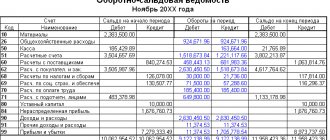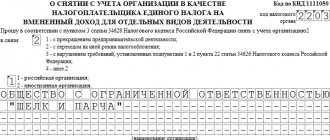What is EVND?
A single tax on imputed income involves a fixed tax on estimated income. This income is determined depending on the specific type of activity. The basic profitability for each type of business is calculated per unit of physical indicator, i.e. per 1 working person, per 1 sq. m of retail or production area, unit of equipment, etc.
An organization or individual entrepreneur is exempt from the following taxes:
- income tax on profits or personal income;
- value added tax (VAT);
- property tax.
In this case, payment obligations remain:
- state duties;
- mineral tax;
- water tax;
- VAT on goods imported from abroad;
- fee for the use of biological resources;
- transport tax;
- land tax.
How to calculate UTII for LLC
As a rule, entrepreneurs do not have any difficulties in independently maintaining LLC accounting on UTII. The amount of the single tax is calculated based on the standard indicators specified in the Tax Code of the Russian Federation. The tax base is imputed income. In other words, the amount of tax deductions depends on the potential income of the taxpayer.
The tax base is determined by multiplying the basic profitability (for the tax period) for a specific line of business by the value of the physical indicator for this type of activity. Basic profitability can be adjusted by coefficients K1 and K2.
Formula for calculating the taxable base:
NB = DB x K1 x K2 x (FP1 + FP2 + FP3) , where:
- NB – tax base;
- BD – basic profitability of a certain type of activity;
- K1 – deflator coefficient. Its value is established annually at the federal level. The value of the coefficient corresponds to the indexation of consumer prices for various categories of goods and services.
- K2 – adjustment coefficient of basic profitability. Its value is determined by local authorities based on the totality of the specifics of doing business (list of goods, services, etc.).
- FP1, FP2, FP3 – values of the physical indicator established for each type of activity in the first, second and third months of the quarter, respectively. The values of basic profitability and physical indicator are regulated by Art. 346.29 of the Tax Code of the Russian Federation and depend on the specific line of business.
Formula for calculating the single tax:
UTII = (NB * NS) - SV , where
SV – insurance premiums;
NS – tax rate for UTII. It is equal to 15% for everyone.
The amount of tax can be reduced by the amount of payments (contributions) and benefits paid by the employer to employees (for employees), provided that the latter are engaged in the area of activity for which the tax is paid.
Insurance premiums also reduce the amount of UTII, but not more than 50 percent of the original amount.
The payment order for the transfer of payment must correctly indicate the BCC (budget classification code).
Conditions for the transition to UTII
First of all, you need to understand that UTII is a regime available only to small and medium-sized businesses. Large enterprises will no longer be able to use it. In addition, there are a number of additional conditions:
- the number of employees should not exceed 100 people;
- the activity should not include leasing of gas stations;
- the share of participation of third-party organizations should be no more than 25%;
- the company has not been granted the status of a state or municipal governing body;
- commercial activity is included in the list of types of economic activity approved by the Tax Code of the Russian Federation (Article 346.29);
- the company is not a simple partnership and is not held in trust.
Article 346.26 of the Tax Code specifies exactly what types of activities allow the use of UTII. For example, this includes activities such as vehicle repair, veterinary services, and distribution of outdoor advertising. You can find the full list in the second paragraph of this Tax Code article.
Please note that it is necessary to find out the decision of local authorities regarding the chosen activity! The rules for applying UTII may differ in regions, as is directly stated in the above article.
The essence of “imputation”
UTII is one of the special tax regimes. Individual entrepreneurs who use it are classified in a separate category. Fiscal policy towards such businessmen is completely different than towards those who work on the “simplified”, general system. The rules for accounting for individual entrepreneurs on UTII in 2020 are also their own.
In addition, not every entrepreneur can choose a UTII. The fact is that his activities should be included in a special list.
The main difference between UTII and the simplified tax system and the general regime is that the amount of income and the corresponding tax are, as it were, imputed to the entrepreneur. Based on the target indicators approved by tax legislation, such businessmen make contributions to the budget. Amounts depend on:
- physical indicators;
- areas of activity;
- region of location.
At the following link you can download the individual entrepreneur’s application for the use of UTII.
“Imputement” involves a number of features related to the payment of taxes. And it also imposes some specific responsibilities on the merchant. Therefore, businessmen often ask the question whether the individual entrepreneur keeps accounting records on UTII.
So: accounting is not the responsibility of individual entrepreneurs working on an “imputed” basis. But there are some nuances. Although, apparently, no changes in this area are expected for 2020.
How to keep records on UTII? Rules and features.
The declaration is submitted after the end of the quarter by the 20th day of the month following the quarter. Tax must be paid by the 25th of the same month.
Cash discipline
Both organizations and individual entrepreneurs are required to observe cash discipline if their type of activity does not allow working without a cash register. For example, entrepreneurs who rent out residential premises that belong to them can work without a cash register.
Accounting for income and expenses under UTII
Small businesses are allowed to use the cash method, that is, take into account income and expenses after they have been paid. But everyone else conducts accounting using the accrual method, in accordance with PBU 9/99 “Income of the organization” and PBU 10/99 “Expenses of the organization.”
Abbreviated chart of accounts
Small businesses can use the chart of accounts in an abbreviated form, creating it on the basis of a regular one. In this case, several accounts are replaced by one common one.
For example, account 20 can combine data from accounts 23, 25, 26, 28, 29. Account 76 can replace accounts 62, 71, 73, 75 and 79.
Additional relaxations
Small enterprises may not use registers that require a double entry method if the size of their business transactions does not exceed 30 per month, and there is no production with serious material costs.
As an alternative, maintaining a book for recording and reflecting actions arising in the course of daily activities, or a journal for recording business transactions, from which the sources of receipt of material goods and cash balances should be visible. For ease of accounting, manufacturing companies have the right to fill out simplified statements of the status of their accounting accounts.
What reports does an LLC need to submit to UTII?
Let's say an LLC on UTII. How to do accounting and taxation? First of all, the enterprise must timely submit tax returns for unified, land, transport taxes and personal income tax. Certain types of reports are also required. These include reports on the number of employees (to Rosstat), accounting reports, reports to the Pension Fund and the Social Insurance Fund.
The accounting records reflect the following information:
- Salaries, insurance premiums and sick leave payments, etc. If there are no employees in the organization, zero reporting is submitted. However, this does not relieve the manager from the need to annually provide data on the average number of employees (even if they do not exist).
- Business transactions affecting the relationship between income and expenses . This could be cash receipts from customers, salary payments, purchases, etc.
Maintaining accounting for an LLC on UTII involves entering financial information into the report in full.
To do this, you can break the process into several stages:
- Select the person responsible for maintaining the accounting system.
- Develop an accounting policy and schedule quarterly filing of returns.
- Develop and approve a chart of accounts in accordance with Order of the Ministry of Finance of the Russian Federation No. 94n dated October 31, 2000.
- Organize the accounting of primary documents in such a way that data from them is reflected in registers in a timely manner.
- Monitor the deadlines for submitting reports on UTII and employees.
According to Federal Law No. 402, the financial statements include:
- balance sheet in the prescribed form;
- income statement;
- applications that reflect the movement of finances, changes in capital, and the intended use of funds.
The law provides for a simplified form of the balance sheet and profit and loss account. LLCs with the status of a small enterprise have the right to use them.
Formation of accounting reports for UTII
All companies that fall under the definition of “small enterprise” can submit financial statements in a simplified form.
In addition, the following conditions must be met:
- the number of employees does not exceed 100 people;
- sales revenue does not exceed RUB 800 million;
- the share of other legal entities in the authorized capital does not exceed 25%.
Let's look at assets and liabilities for small businesses:
| Assets | Passive |
|
|
The income statement of small businesses also includes a few lines:
How to keep records of individual entrepreneurs with UTII?
The main difference from organizations is that individual entrepreneurs are exempt from the obligation to maintain accounting records and submit financial statements.
Accounting for individual entrepreneurs with UTII
The legislation on accounting does not provide for the obligation to maintain accounting records for UTII by private entrepreneurs and citizens engaged in individual practice.
When conducting activities without registering a legal entity, expenses, income and objects for taxation are recorded in the manner approved by tax legislation.
But during a tax audit, documents relating to the activities of the person being audited may be requested. This provision is interconnected with the clause of the Tax Code obliging taxpayers to store accounting and tax documents for four years, including:
- relating to income receipts,
- confirming the fulfillment of expenses,
- necessary for calculating taxes,
- for the transfer or withholding of taxes.
Failure to provide documents or any information provided for by the Tax Code and other legislative acts within the specified period will result in the imposition of penalties.
According to the Tax Code, entrepreneurs working under taxation in the form of UTII are not required to keep track of income and expenses in the course of their activities. But the payer is obliged to take into account the indicators required for tax calculations.
The procedure for verifying electronic signatures is clearly defined by law, and there are a number of established rules that contain 16 provisions.The validity period of the electronic signature is 365 days. If it has expired and the renewal has not been completed, the owner has another 30 days during which he will be able to renew the old certificate. More details about the validity period of digital signatures can be found in this article.
Therefore, when checking, it will be legal to require documents confirming the legality of using this accounting system and the correctness of tax calculation. These include lease agreements, floor plans, but do not include documents on the amount of income received and expenses incurred.
How to optimize the accounting and tax accounting of a company or individual entrepreneur?
Many ordinary accountants do not have enough experience or free time to simultaneously competently deal with reporting and solve more strategic problems (for example, finding opportunities to reduce expenses or tax payments). It is even worse when an individual entrepreneur is engaged in accounting - as the business grows, he no longer has enough time for accounting and if the accounting is not submitted on time, then errors in documents will begin and subsequent sanctions from the tax authorities.
As a solution, we suggest you contact professional organizations involved in accounting and tax reporting. PROGRAMS 93 LLC is one of these.
Who needs to keep accounting records for UTII?
If a legal entity has chosen a tax on temporary income, it must record services under UTII. It is important to comply with the rules established by the Federal Tax Service.
It is much easier for an individual entrepreneur. He may not be involved in accounting. Additionally, there is no need for cash register equipment and strict reporting forms. However, if the inspector puts forward relevant requirements, it is necessary to confirm the conduct of business activities by providing the necessary documents. This means that physical indicators must still be taken into account.
You can often hear a requirement for individual entrepreneurs to provide an accounting book. In fact, such actions are illegal. The list of physical indicators includes the area of the sales floor and the number of employees. However, the law does not reflect accounting standards. Individual entrepreneurs record data without creating separate books. This is not considered a violation. It is enough just to ensure the safety of the documentation required for calculating taxes.
Why are we not a full-time employee?
- You work with a whole team. You no longer depend on one person, and the work of each specialist is checked by competent people.
- We do not shift our problems onto you. You don't need to organize workspaces or pay sick leave. Moreover, a sick employee is replaced by his colleagues unnoticed by you and work does not stop.
- We have experts of different profiles. Lawyers, 1C specialists - we take a comprehensive approach to accounting and can optimize the work of an entire department, including automating document flow and introducing convenient tools.
Call the phone number listed on the website or fill out the feedback form so that we can guide you on the exact cost, choose the best solution and tell you how to start cooperation!
Position of the Ministry of Finance
In clarifications of 2012 No. 03-11-11/233, the financial department clearly distinguished whether an individual entrepreneur keeps accounting on UTII. This position is unlikely to change in 2020. Here's what the document says:
A) when calculating the imputed tax, a businessman must use a special base.
To determine it, there is a formula: Basic profitability × Size of the physical indicator The value of the latter is determined depending on the type of activity.
B) The individual entrepreneur on the “imputation” must keep records of physical indicators and promptly reflect their changes in documents.
All this makes it possible to conclude that for businessmen working on imputation, the question of whether an individual entrepreneur keeps accounting is closed: maintaining accounting and accounting for income and expenses is not an obligation.
There is one more aspect that the Russian Ministry of Finance paid attention to. Individual entrepreneurs working for UTII pay tax regardless of the
- whether they carried out activities;
- whether they received income during the reporting period.
After starting work on the “imputation”, such businessmen are required to make contributions to the budget in the established amount (clarification No. 03-11-11/8433 of 2015).
Individual entrepreneurs who pay UTII should not keep books recording income received and expenses incurred, since this obligation does not apply to them.
The rule about the absence of the need to maintain [accounting for individual entrepreneurs on UTII (in 2019 and before), as well as accounting for income and expenses, was enshrined in law more than 10 years ago. Since then, no innovations have been adopted. Neither in 2020 nor in 2019 are individual entrepreneurs required to keep accounting records on UTII.
Due dates
The timing and frequency of reporting depends on their type:
Accounting statements for UTII must be submitted once a year. As for the deadline, it is set at March 30 of the year following the reporting period.
Declaration. The frequency of its delivery is 4 times a year, that is, quarterly. Specific deadlines for each quarter:
- reporting for the first quarter must be submitted no later than April 20 of the reporting year;
- for half a year – until July 20;
- 9 months before October 20;
- final declaration for the entire year - until January 20 of the new year.
These deadlines can be extended by several days if the 20th of one of these months falls on a non-working day - a weekend or a holiday. In this case, reports can be submitted on the next business day after this date.
As for paying the tax itself, the principle of setting deadlines is the same - it must be paid quarterly, only the deadline will no longer be the 20th, but the 25th of each listed month - April, July, October and January.
The average number of employees for the last year - it is submitted by all enterprises and entrepreneurs by January 20 of the current year.
Reports on other taxes for the tax office:
- Transport - paid once a year, based on the results of the previous period. In this case, the specific deadline for submitting tax calculations is agreed upon with the local authorities of the Federal Tax Service.
- Water - the frequency of submitting the calculation is the same as for the declaration, that is, until the 20th of each of the listed months.
- Land – payment is due every three months, until the end of April, July, October and January.
Employee income certificate – submitted by April 1 of the year following the reporting period.
Calculations according to the 4FSS form are due every three months, until the 15th.
Individual information about employees – 4 times a year:
- for the first quarter – until May 15;
- for half a year - until August 15;
- 9 months before November 15;
- for the whole year - until February 15 (new year).
It should be remembered that the deadline also covers the possibility of submitting amended reports. If a document was filled out incorrectly or the numbers calculated in it do not correspond to reality, the entrepreneur can bring an updated and corrected form. At the same time, compliance with deadlines is mandatory. Therefore, it is better not to delay and submit reports taking into account possible changes. Filling out the reporting must be accurate - blots and corrections in the submitted document are undesirable.
In case of violation of these deadlines, individual entrepreneurs and LLCs may be subject to liability in the form of a fine (the amount is different for each overdue document). However, payment of this fine still does not exempt the taxpayer from filing reports.
Individual entrepreneur on OSNO and UTII - separate accounting
The simultaneous application of general and imputed taxation systems requires the organization and reliable maintenance of separate accounting for property objects, obligations and business operations (clause 7 of Article 346.26 of the Tax Code). The separate accounting methodology is approved in the entrepreneur's accounting policy. In this case, it is necessary to separate the indicators directly involved in the calculation of taxes paid. In particular, these are values such as:
- Individual entrepreneur income and expenses - separate accounting of income is required for the correct calculation of income tax. The distribution of expenses is legally carried out according to the norms of paragraph 9 of Article. 274 Tax Code - in proportion to the value of the income received.
- Input VAT - separation is necessary for the correctness and legality of the subsequent acceptance of tax under OSNO for deductions. In the absence of separation, it is prohibited to deduct input VAT (paragraph 6, paragraph 4, article 170 of the Tax Code). An exception is periods for which the share of expenses on UTII is less than 5% of the total cost, in this case it is allowed to deduct the entire VAT on purchased goods and materials (paragraph 7, paragraph 4, Article 170 of the Tax Code).
- Property objects – for the purpose of calculating and paying property tax.
- Insurance premiums and staff salaries - in order to reduce the single tax on UTII and correctly attribute social amounts to profit expenses.
General information about UTII
If a company on UTII belongs to small enterprises, then accounting is allowed to be carried out in an abbreviated form without detailing individual indicators, but information on accrued and paid taxes will have to be shown in any case.
The UTII regime is a special one; a single tax replaces a number of other taxes:
- For individual entrepreneurs – tax on personal income, property of individuals, added value;
- For LLCs – income tax, value added tax, property of legal entities (with the exception of those where the cadastral value serves as the tax base).
From the point of view of the tax burden on an entrepreneur, the regime is convenient if there is profit (income). Regardless of their value, a single tax will be paid in a fixed amount, which will depend only on the basic profitability for a specific activity established by the Tax Code of the Russian Federation, adjustment coefficients, as well as physical indicators.
These components have a specific meaning, some of them are established for the Russian Federation as a whole, others - by local legislative acts. Moreover, this value does not depend in any way on the actual result of entrepreneurial activity. This is beneficial for entrepreneurs with a significant amount of income or profit; the tax burden with UTII is less than when calculating tax on income (for individual entrepreneurs) or on profit (for legal entities) under the general regime.
However, the benefit disappears as soon as the entrepreneur’s income decreases. A situation is possible in which the result from activities for a quarter is zero, negative or too small, and the single tax has to be paid in the same amount as for other quarters.
| ★ Best-selling book “Accounting from scratch” for dummies (understand how to do accounting in 72 hours) > 8,000 books purchased |
- The average number of personnel is within 100;
- The company is not a large tax payer;
- The activity falls within the established Tax Code of the Russian Federation;
- Own share in the management company is at least 75%.
The figure below shows the advantages and disadvantages of switching to UTII in the form of infographics.
Accrual of UTII
Thus, an individual entrepreneur or a legal entity on UTII quarterly calculates the special tax and reflects the accrual and payment entries.
The calculation is carried out as of the last day of the quarter, on the same day the result of the calculation is reflected in accounting using the entry for the accrual of UTII.
If an enterprise applies UTII in several areas, then a separate calculation is carried out for each, since the imputed income will differ according to the established basic profitability and other indicators.
| ★ Best-selling book “Accounting from scratch” for dummies (understand how to do accounting in 72 hours) > 8,000 books purchased |
How to calculate UTII tax for individual entrepreneurs in 2020
Payment period. The tax amount you calculate must be paid by the 25th of the first month after the end of the tax period. If the last day of payment falls on a weekend, transfer the money to the budget on the next closest working day. Payment deadlines in 2020:
- 1st quarter - until April 27;
- 2nd quarter - until July 27;
- 3rd quarter - until October 26.
Based on the results of 2020, UTII must be paid by January 25, 2021.
Payment details. You can pay tax only using the details of the tax service of the region where you operate. In this case, you must be registered as an imputation taxpayer. There are types of activities to which these standards do not apply:
- delivery and distribution trade;
- advertising in transport;
- passenger and cargo transportation.
Individual entrepreneurs engaged in these types of activities pay tax from the place where the main office of the enterprise is located, since the exact address of the activity is impossible to determine.
Liability for non-payment. If the tax was not paid on time, the individual entrepreneur will be held accountable. It could be:
- collection of tax shortfalls;
- a fine of 20% of the debt amount if the payment was not made by the payer unintentionally;
- a fine of 40% of the debt amount if non-payment of tax was intentional;
- For each day of delay, a penalty is charged.
Accounting policy of individual entrepreneurs on UTII - sample
Since, according to Law No. 402-FZ of December 6, 2011, individual entrepreneurs are not required to keep accounting if the above conditions are met, in most cases there is also no need to develop an accounting policy. This document may be needed by those entrepreneurs who carry out various types of activities with a combination of modes. When forming, the order approves methods for separate accounting of income, the procedure for distributing incoming VAT in terms of goods (works, services) acquired by individual entrepreneurs, insurance premiums and wages, and expenses.
In the future, accounting policies will help justify the correctness of calculations and payment of taxes. The order is kept by the entrepreneur and can be requested during tax audits. Samples of this document are freely available on the Internet.
Postings for reflecting UTII
In the Chart of Accounts, for recording data on tax amounts, account 68 is provided, into which subaccounts taxes are distributed. Each individual tax type is shown in a separate subaccount.
To calculate UTII, a sub-account is opened on account 68, the debit shows the tax amounts transferred to the budget, and the credit shows the accrued amounts.
The calculated tax is included in the organization's losses in account 99. The corresponding wiring looks like this:
Deb. 99 Cr. 68.UTII – reflects the accrual of a special tax for UTII.
The date of the double entry is the last day of the quarter for which the calculation is performed:
- March 31 for the first quarter;
- June 30 for 6 months;
- September 30 for 9 months;
- December 31st for the year.
The calculated amount must be transferred within 25 calendar days from the date of accrual. The corresponding double entry in accounting looks like this:
Deb. 68.UTII Kr. 51 – special UTII tax was paid by non-cash means.
At the end of the calendar year, this tax, as part of the total profit (loss), will be written off to account 84 using the entries:
- Deb. 99 Cr. 84 – if the total for the year is profit;
- Deb. 84 Cr. 99 – if the result for the year is a loss.
Example of UTII calculation
Firma LLC retails bakery products through a store of 30 sq.m. For the region where the company is located, the profitability is set at 1,800 rubles. per sq.m. K2 = 0.35. The physical indicator of this direction is the store area in sq.m. The rate for the region is 15%. Tax payment is due on April 20.
At the end of the 1st quarter on March 31, the company's accountant calculates the tax for the quarter.
UTII = 1800 * 1.798 * 0.35 (30 + 30 + 30) * 15% = 15292 rub.
In accounting, the accountant shows the following entries:
| date | Operation | Sum | Debit | Credit |
| 31.03 | A special tax was accrued for UTII for the first quarter. | 15292 | 99 | 68.UTII |
| 20.04 | Tax for the first quarter paid from the account. | 15292 | 68.UTII | 51 |
The calculation is carried out using an accounting certificate, on the basis of which the first posting is made. The documentary basis for making the second entry is a payment order. The above transactions are made once a quarter even if no transactions are performed.
This is a significant disadvantage of the imputed regime. The organization bears the tax burden even if it receives losses or has no transactions for the quarter. It is recommended that the “imputed” notify the tax office of the suspension of activities in order not to pay extra tax amounts.









